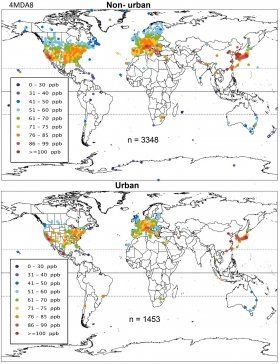That's one conclusion from a new health assessment based on the Tropospheric Ozone Assessment Report or TOAR, an effort by the International Global Atmospheric Chemistry Project to create the world’s most comprehensive database of surface ozone observations from all available ozone monitoring stations around the globe. The paper was published today in the journal Elementa: Science of the Anthropocene.
The international scientists who compiled and analyzed the global ozone pollution database hope it will give scientists and public health managers better insight on trends and patterns of human health exposure around the world.
“TOAR is not just a report,” said Owen Cooper, a CIRES scientist working at NOAA who chairs the TOAR Steering Committee and has been working to develop the assessment since 2014. “We created the largest database of surface ozone from hourly observations at more than 4,800 monitoring sites worldwide, and we’re making these data freely available to anyone who wants to investigate the impact of ozone on human health, vegetation, and climate.”
Read more at University of Colorado Boulder
Image: Average number of days per year (2010-2014 average) when ozone levels exceed the US health-based air quality standard of 70 parts per billion (ppb) averaged over eight hours, at non-urban and urban sites. People in parts of California, Arizona, Colorado, Texas, the Midwest and the Middle Atlantic experienced more than 15 days a year with ozone pollution readings higher than 70 ppb. (Credit: TOAR/Elementa)


